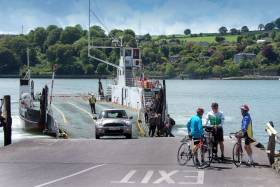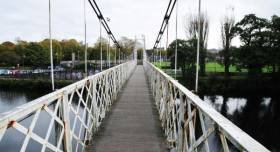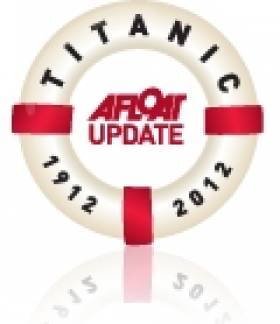Displaying items by tag: River Lee
River Lee Light Rail Bridge Plans ‘Could Sterilise Cork City For Future Generations’
Plans for a new light rail bridge across the River Lee in Cork city centre have sparked concerns that the project would prevent any passage of vessels and “sterilise the city forever for future generations”.
The Echo reported last week on the multi-billion-euro transport plan for Cork that includes a light rail system similar to the Luas in Dublin, with a 25-stop route that could cross the city via a new bridge at Kent Station to the South Docklands.
This is the proposal that has raised the ire of Michael McCarthy, chairman of cruising industry network Cruise Europe, who fears the bridge would cut off the city from its maritime heritage.
McCarthy cites the pontoon by the coffee pods on Lapps Quay — “nothing but a few small rowing boats” — as an example of what could happen to the city without free access for vessels of all sizes.
And he argues that some councillors and officials who will be responsible for considering these plans have “no feel or empathy for the maritime or the marine”.
“The river made Cork City what it is today and now they are intent on sterilising it for ever when there is a very viable alternative,” he adds — suggesting that the light rail system could instead follow the old Cork-Blackrock-Passage-Crosshaven line using the existing bridges from Kent Station to City Hall.
Cork City councillors were briefed last week by the National Transport Authority on the plans, which form part of the Cork Metropolitan Area Transport Strategy (CMATS).
Next month a specialist team will be commissioned to analyse all route options for the scheme, which is expected to cost €1 billion in total. The Echo has more on the story HERE.
#ferries - Owners of the River Lee car ferry service in Cork harbour, the Irish Examiner reports, have told Cork County Council they don't believe it's economically viable to put on a second ferry at peak evening times.
Doyle Shipping Group (also operators of Cross River Ferries) contacted Paraic Lynch, municipal officer for the Cobh/Glanmire Municipal District Council, to tell him the news after a number of councillors petitioned the company to beef up their service from Glenbrook, on the Passage West side to Carrigaloe, on the Cobh side.
Councillors living in the Cobh area are particularly concerned about the length of time it is taking people to get across the harbour from the Glenbrook side during the evening rush-hour period.
Mr Lynch told the councillors that Doyle Shipping had contacted him to say they didn't see it as viable to operate two ferries at that time. However, he added that the company says it will continue to monitor the situation, especially when major work gets underway on the €100m upgrade of the Jack Lynch Tunnel/Dunkettle interchange later this year.
Councillors are particularly concerned about that as they believe it will drive more motorists to use the cross-river ferry to avoid delays at the northern side of the tunnel as the upgrade works get underway.
For further comments by councillors following the decision announced by the shipping group click here.
Dear Editor,
I moved to Inchigeelagh, Co Cork last October. My first Summer here is being filled with admiring all of the beautiful scenery.
I've got a bug about sailing in the local lake that just won't go away, I'm sure you understand! :)
The trouble is that I've no idea about how to go about it, where to enquire, what kind of boat I'd be allowed to take out, what size engine is allowed etc.
It's not for fishing, just to go sail in circles with the kids on a nice day and perhaps sleep on board for the night before going back home after a day or two.
Please tell me it's allowed and easy to go about?
Any help would be greatly appreciated,
Thanking You,
Con
Afloat.ie replies: The lovely Lough Allua on the upper River Lee above Inchigeelagh has been enlarged by the Hydro-electric dam at Carrigadrohid to provide an impressive lake which is renowned for its angling (pike fishing especially), and it is also used by kayakers - both for the pleasures of the lake itself, and as part of the transit of the River Lee from source to sea.
However, the presence of old tree stumps hidden just below the surface – often a hazard when water-levels have been raised – may make sailing hazardous in some locations. We suggest that Con contact Eddie English of SailCork, who would know of any sailing enthusiasts in the neighbourhood – [email protected]
Shakey Bridge in Cork May be One ‘Shake’ from Collapse
#InlandWaterways - An urgent health-and-safety audit of Shakey Bridge in Cork have been called for amid fears the iconic city structure could be one shake from collapse.
As the Irish Examiner writes, historian and city councillor Kieran McCarthy said it was shocking to see one of the city’s best-known landmarks and tourist attractions — the city’s only suspension bridge, famous for its wobble — decay to such a dangerous state.
“Urgent action is required before we have to make the sad call to close it off to the public completely,” he said. “That would be a shame.”
As talks continue over the city’s 2019 budget, he plans to ask the city council’s chief executive, Ann Doherty, to urgently identify and set aside funding to repair the bridge which was officially opened 90 years ago.
Daly’s Bridge is a 48m-span wrought-iron suspension pedestrian bridge which was built by a London-based company over the northern channel of the River Lee in 1927 to a design by former Cork City architect Stephen Farrington.
To read much more on this story including photos of the rusting bridge's lattice-work structure, click here.
Temporary Stink Expected As River Lee Bed is Dredged
#portofcork - Along the River Lee is where an expected stink is to eminate in the coming days as the Port of Cork dredges the riverbed.
As the Evening Echo writes, every three years the Port of Cork carries out dredging work in the harbour and the quaysides to maintain the shipping channel. The work disturbs the riverbed, dragging up sediment and releasing gases like hydrogen sulphide. While the gases are safe, they are responsible for the eggy smell that could hang over the river in the coming days.
In 2014, Barrack Street, MacCurtain Street, Shandon, North Main Street, Patrick’s Street and Merchant’s Quay were all affected by the smell as a result of dredging. However, it was thought the lack ro rain and warm temperatures exacerbated the situation at that time.
The current dredging scheme is expected to last until the end of October but the city quays portion is planned to be completed by October 9, limiting the smell in the city centre. The Port of Cork said it is taking measures to limit the impact.
For more on the dredging by clicking here.
Divers Find Car In River Lee After Morning Search
#RiverLee - Divers have found a car submerged in the River Lee in Cork just hours after it was seen entering the water this morning (Friday 6 May).
BreakingNews.ie reports that a member of the public spotted the vehicle near the Lee Rowing Club with its boot sticking out of the water around 6am, prompting an immediate search and rescue response.
The car was subsequently located after a search of the river and divers from Haulbowline are assessing the scene, as RTÉ News reports.
In other news, a young tourist is recovering after he was swept onto rocks by an unexpected wave at Doolin in Co Clare yesterday (Thursday 5 May).
The 25-year-old American sustained multiple injuries after the wave knocked him off the shoreline at the popular beauty spot, according to BreakingNews.ie.
Man Arrested After Falling Into River Lee
#Cork - The search for a homeless man seen falling into the River Lee in Cork city ended in his arrest, as The Irish Times reports.
Valentia Coast Guard co-ordinated the search and rescue operation for the man, who was witnessed falling into the water after 7am yesterday morning (Saturday 21 March).
However the man was quickly discovered by emergency personnel on a support beneath Parnell Bridge, refusing to come out.
The Irish Times has more on the story HERE.
#Drowning - Three drownings over the weekend have underlined the importance of safety on the water during the current sunny spell.
In Galway, residents of Moycullen were mourning the loss of a Lithuanian man who drowned while swimming with friends in Ballyquirke Lake on Saturday evening 8 June, according to Galway Bay FM.
And RTÉ News reports of a similar incident in Cork in the early hours of this morning 10 June, in which a 21-year-old man drowned after getting into difficulties in the River Lee near Ballincollig.
The young man is also believed to have been swimming with friends after another hot day across the country, according to The Irish Times.
Elsewhere in Cork, RTÉ News says a 17-year-old has died after drowning in the River Blackwater.
Earlier it was reported that the teen was in a serious condition after getting into difficulties while swimming with friends at a bathing spit known locally as Lisheen Bridge, and had been in the water for some time before he was recovered.
Royal Navy Attend Presidential Fleet Review for Cobh Titanic 100
#COBH TITANIC 100 - Following President Michael D. Higgins visit to Cobh to commemorate the centenary call of RMS Titanic to Queenstown, the town yesterday hosted a Naval Service review that included the Royal Navy's HMS Mersey.
The President as supreme commander of the Defence Forces boarded the Naval Service 'flagship' L.E. Eithne which passed the guest-ship, a River class patrol vessel which headed a line of vessels which lay at anchor of Cobh's waterfront, they were the L.E. Aoife, L.E. Aisling and L.E. Niamh
The historic event which marked the pinnacle of the Titanic 100 Cobh centenary week will continue as part of a year-round programme of events. For information visit www.titanic100.ie. On the homepage the L.E. Niamh features again, where on this occasion marine photographer Jehan Ashmore captured the vessel underway as she powered her way at high-speed through a misty Dalkey Sound.
Among the many places throughout Cobh where thousands of tourists have flocked since the Balmoral docked on Monday to retrace the liner's maiden voyage, has been the White Star Line pier.
From this pier were the last passengers to depart Queenstown on board the tenders PS Ireland and PS America to the ill-fated Titanic that struck an ice-berg. On her Irish call 123 passengers were transferred to the Titanic which lay outside Cork Harbour, while 7 passengers disembarked from the liner and headed ashore.
What remains of the pier which is not accessible to the public and is in danger of collapsing, there has been calls to raise funds to save the structure, as previously reported.
Also in attendance during yesterday's historic proceedings, was the excursion passenger tender Spirit if the Isles which is operating on her second season since starting Cork Harbour cruises last year. They run between Cork city quays and downriver along the Lee to Cobh.
In the 1980's the tender then named Ingot ran excursions from Dun Laoghaire Harbour into Dublin Bay and likewise of L.E. Niamh, she too transited Dalkey Sound as part of her sightseeing tours.
- RMS Titanic
- White Star Line
- Cobh Cruise Callers
- Cobh, Cork Harbour
- Cruiseships
- Balmoral
- FredOlsen Cruise Lines
- Titanic Memorial Cruise
- naval service
- LEEithne
- Royal Navy
- HMS Mersey
- President Michael D Higgins
- Queenstown,Ireland
- PS Ireland
- PS America
- Spirit of the Isles
- Cork Harbour Cruises
- Cork Harbour News
- Dalkey Sound
- LE Niamh
- LE Aoife
- LE Aisling
- Cork Harbour
- River Class Patrol vessels
- River Lee
- Irish marine photographers
'Eagle-Eyed' Angler Fishes Wedding Ring from the Lee
#ANGLING - An "eagle-eyed" angler in Co Cork received a free eye test after his remarkable find of a wedding ring in the water last week.
Seventy-five-year-old Pat O'Flaherty spotted the €400 gold band - complete with its red box - in the River Lee, garnering him a front-page story in the Irish Examiner and a free eye test from Specsavers.
They put me in the chair and did all the tests and told me I have 20:20 vision," he said.
The owner of the ring has yet to be traced, despite much speculation as to how it ended up in the Lee in the first place. If unclaimed, O'Flaherty intends to auction the ring for charity.
In other angling news, West Cork's Courtmacsherry Angling Centre hosted members of the Bradford Sea Angling Club in the UK last weekend.
Poor weather meant that the group was restricted to inshore fishing on the Friday and Saturday, but the Sunday saw a catch of ling up to 23lbs as well as pollack, coalfish, cod, haddock and whiting.






































































